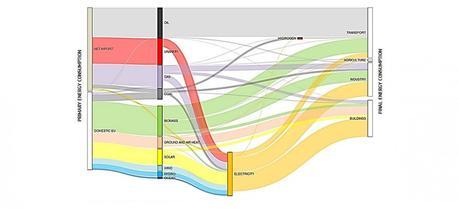 Major energy flows in an exemplary decarbonised EU28 in 2050, JRC-EU-TIMES model run (Credit: EU, acknowledgement for use of d3.js and sankey diagram to Mike Bostok)
Major energy flows in an exemplary decarbonised EU28 in 2050, JRC-EU-TIMES model run (Credit: EU, acknowledgement for use of d3.js and sankey diagram to Mike Bostok)The JRC-EU-TIMES model by the Joint Research Center (JRC), the EU in-house scientific service, described in a recently published report, assesses the role of energy technologies in meeting Europe’s energy and climate change objectives, such as a 40% reduction of greenhouse gases below 1990 levels by 2030.
The JRC-EU-TIMES model covers the EU28 energy system plus Norway, Switzerland, Iceland and the Balkan countries from 2005 to 2050, modeling technology uptake and deployment and its interaction with the energy infrastructure. The JRC-EU-TIMES model considers both energy supply and demand and includes the following seven sectors: primary energy supply, electricity generation, industry, the residential sector, the commercial sector, agriculture and transport.
The report describes a number of model outputs from a reference scenario and seven potential decarbonized pathways. The scenarios do not represent a quantified view of the European Commission on the future EU energy mix, but are nonetheless useful to explore the capacities of the model. The reference scenario is the Current Policy Initiatives scenario (CPI) that takes into account the 20-20-20 policy targets. The seven decarbonised pathways are the Cap85 scenario (a CO2 reduction of 85% below 1990 values in 2050) and the following variants: exploring different contribution of carbon capture and storage (PATH1); higher social acceptance of renewable energy sources plants (PATH2); social acceptance of nuclear plants (PATH3); stricter and more effective end-use energy efficiency requirements (PATH4); lower biomass availability for the energy system (PATH5); and higher requirements for the reliability of transmission and distribution, reducing the share of intermittent variable solar and wind electricity (PATH6).
The results of these scenarios indicate that innovative energy technologies can play an important role, reducing the carbon intensity of the energy system (CO2 per energy) by up to 80%. Coupled with demand reductions, the energy intensity of production (energy per GDP) is also reduced by 60%. A strong requirement for the transformation into such a low-carbon society is investment in technology, especially in power generation, but also in cars, industrial production facilities and heating systems. For instance, in the scenarios, technology investment has to increase by 20% in 2050 over the reference scenario, leading to a 50% reduction in fuel costs in Europe.
The publishing of the report follows the peer-review and validation of the JRC-EU-TIMES model that involved experienced modelers as well as policy makers. The validation process confirmed the capabilities of the model, which was praised as one of the most comprehensive, ensuring maximum transparency in model inputs and mechanisms. Based on feedback, the JRC aims to continue improving the model.
Earlier we reported that several leading European companies are calling for an ambitious EU renewable energy target, including binding national targets.

